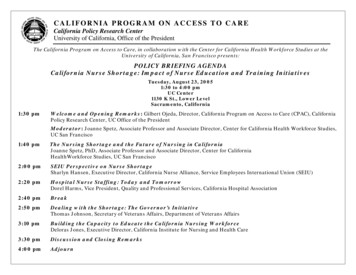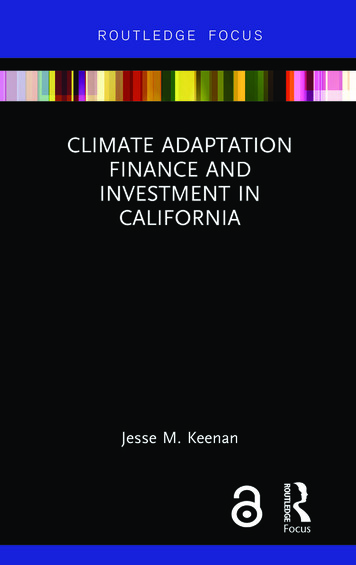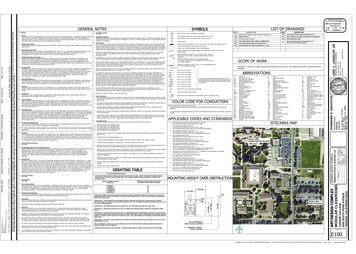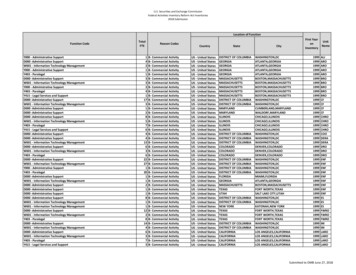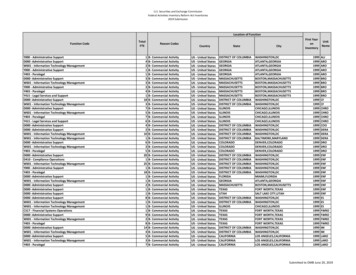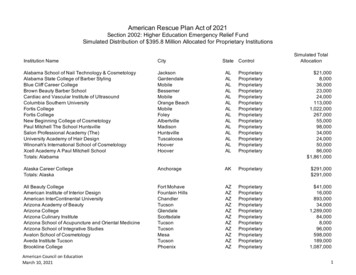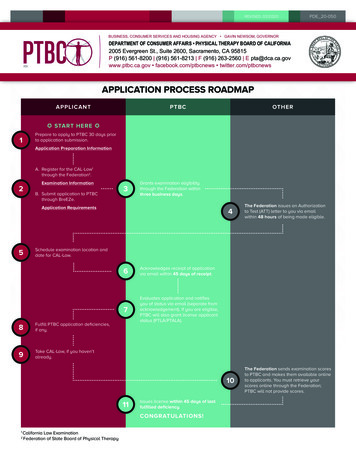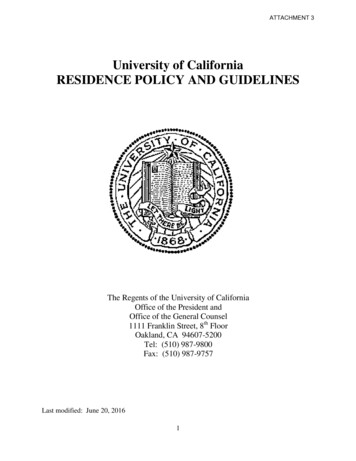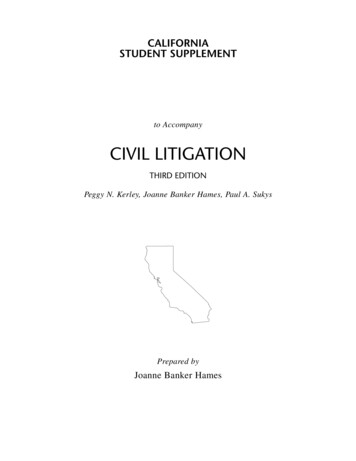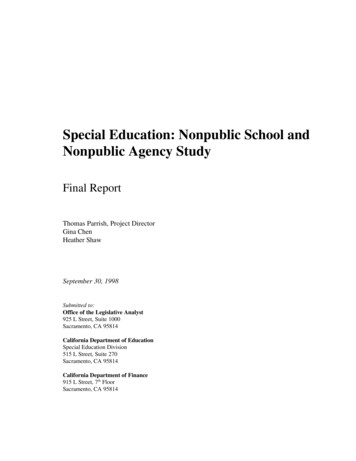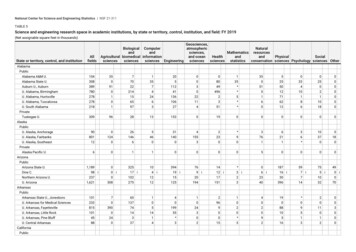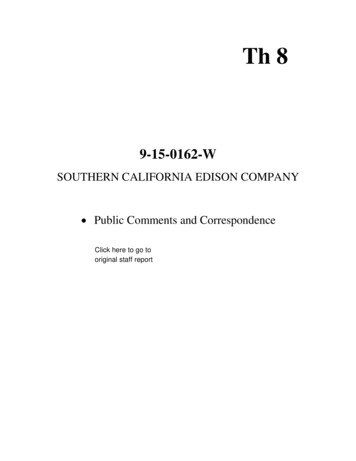
Transcription
Th 89-15-0162-WSOUTHERN CALIFORNIA EDISON COMPANY Public Comments and CorrespondenceClick here to go tooriginal staff report
STATE OF CALIFORNI A—NATURAL RESOURCES AGENCYEDMUND G. BROW N, JR., G O VERNO RCALIFORNIA COASTAL COMMISSION45 FREMONT, SUITE 2000SAN FRANCISCO, CA 94105- 2219VOICE AND TDD (415) 904- 5200FAX ( 415) 904- 5400Th 8ENERGY, OCEAN RESOURCES, AND FEDERAL CONSISTENCY DIVISION REPORTFOR THEMAY 14, 2015 MEETING OF THE CALIFORNIA COASTAL COMMISSIONTO:Commissioners and Interested PartiesFROM:Alison Dettmer, Deputy DirectorEnergy, Ocean Resources & Federal ConsistencyIMMATERIAL AMENDMENTAPPLICANTE-11-017-A2Pacific Gas and ElectricCompanyPROJECTLOCATIONRecovery and removal of four (4) ocean bottom Diablo Canyon Power Plantseismometer (OBS) and an associated power andSan Luis Obispo Countydata cable within the coastal zone offshore of theDiablo Canyon Power Plant.DE MINIMIS WAIVERSAPPLICANTAPPLICANT9-15-0162-WSouthern California EdisonCompanyInstall an independent cooling system knownas a “Spent Fuel Pool Island” (SFPI) to replacethe existing once-through cooling system atSONGS Units 2&3.San Onofre NuclearGenerating Station (SONGS)San Diego County9-15-0417-WSouthern California EdisonCompanyReplace SONGS current salt water coolingpumps with smaller dilution pumps, install two(2) chillers that are not dependent on oceanwater cooling, and reroute effluent dischargepipes.San Onofre NuclearGenerating Station (SONGS)San Diego County9-15-0431-WMontecito Water DistrictUse non-invasive geophysical surveytechniques along the shoreline and nearshorewaters in Montecito using geophone arrays todetermine the feasibility of siting a subsurfaceintake for seawater desalination.DEPUTY DIRECTOR’S REPORTAPPLICANTMontecito, Santa BarbaraCountyPAGE 1 OF 3
9-15-0436-WSouthern California EdisonCompanyExtend the project life of two (2) temporaryseawater pumps installed on a boat ramp at theUniversity of Southern California WrigleyInstitute.Wrigley Institute forEnvironmental StudiesSanta Catalina Island, LosAngeles CountyNO EFFECTS NDAGElvira to Morena Double-Track ProjectAction: No effects, 4/22/2015East of La JollaSan DiegoNE-0002-15San Diego Yacht ClubDisposal of 10,690 cu. yds. of dredge materialAction: No effects, 5/7/2015LA-5 Offshore Disposal SiteOffshore San DiegoNEGATIVE S. Coast GuardInstall security fencingAction: Concur, 4/30/2015Coast Guard Stations inInverness (Point Reyes) andBolinas, Marin CountyND-0007-15National Park ServiceSacramento Landing Pier Repair in FuelLine InstallationAction: Concur, 5/7/2015Tomales Bay, Pt. ReyesNational Seashore, Marin Co.ND-0008-15U.S. Coast GuardPier RepairsAction: Concur, 5/8/2015Coast Guard StationMontereyND-0009-15Department of the NavyNorthwest Training and Testing(NWTT) ActivitiesAction: Object, 4/28/2015Offshore Humboldt and DelNorte Counties, NorthernCaliforniaND-0011-15U.S. Fish and WildlifeServiceWhite Slough Tidal Restoration ProjectAction: Concur, 5/1/2015Humboldt Bay NationalWildlife RefugeHumboldt CountyDEPUTY DIRECTOR’S REPORTPAGE 2 OF 3
ND-0012-15U.S. Army Corps ofEngineersBreakwater RepairsAction: Concur, 4/23/2015Los Angeles-Long BeachHarborsND-0014-15Department of VeteransAffairsConstruction of Mental health and CommunityLiving Center FacilitiesAction: Concur, 4/23/15VA Medical CenterLong Beach, Los Angeles Co.DEPUTY DIRECTOR’S REPORTPAGE 3 OF 3
STATE OF CALIFORNIA - NATURAL RESOURCES AGENCYEDMUND G. BROWN, JR., Governo rCALIFORNIA COASTAL COMMISSIONENERGY, OCEAN RESOURCES AND FEDERAL CONSISTENCY DIVISION45 FREMONT STREETSUITE 2000PH (415) 904-5200 FAX (415) 904-5400WWW.COASTAL.CA.GOVNOTICE OF PROPOSED IMMATERIAL PERMITAMENDMENTCoastal Development Permit Amendment No. E-11-017-A2April 30, 2015To:All Interested PartiesFrom:Charles Lester, Executive DirectorSubject:Coastal Development Permit No. E-11-017 granted to Pacific Gas & Electric Co.for: installation and operation of an array of short- and long-term seismic activitymonitoring devices (ocean bottom seismometers) on the seafloor and approximately11 miles of associated power and data cable within the coastal zone offshore of theDiablo Canyon Power Plant, San Luis Obispo County.Project Site: OCEAN WATERS OFFSHORE OF THE DIABLO CANYON POWER PLANT,SAN LUIS OBISPO COUNTYThe Executive Director of the California Coastal Commission has reviewed a proposed amendmentto the above referenced permit, which would result in the following change(s):Recovery and removal of a long-term offshore seismic monitoring array consisting offour ocean bottom seismometer (OBS) units and an associated 11 mile long powerand data cable and recovery and redeployment of a temporary offshore seismicmonitoring array consisting of four un-cabled OBS units from the seafloor offshoreof the Diablo Canyon Power Plant.FINDINGSPursuant to 14 Cal. Admin. Code Section 13166(b) this amendment is considered to beIMMATERIAL and the permit will be amended accordingly if no written objections are receivedwithin ten working days of the date of this notice. If an objection is received, the amendment mustbe reported to the Commission at the next regularly scheduled Commission hearing. Thisamendment has been considered "immaterial" for the following reason(s):The long-term seismic monitoring array that is proposed to be removed was authorized by theCommission in CDP No. E-11-017 and installed in November of 2013. This array was placedprimarily in areas of soft substrate seafloor offshore of the Diablo Canyon Power Plant. The tensquare foot ocean bottom seismometer (OBS) units and roughly two-inch diameter cable were placedon the seafloor and not buried. Although intended to be operational for approximately ten years,shortly after installation, data transmission from the array’s long-term OBS units ceased. Shortlythereafter, PG&E received from the Commission CDP Amendment No. E-11-017-A1 for the installation
Page 2Notice of Proposed Immaterial Permit AmendmentE-11-017-A2of four un-cabled temporary OBS units in areas near the previously installed non-operational units.PG&E is now proposing to recover and redeploy the temporary OBS units (after battery replacement anddata download) and to remove the non-operational OBS array. Three of the temporary OBS units wouldbe redeployed in the same locations and one would be moved approximately one mile to its initiallyintended installation site (a post-installation survey revealed that it had been installed in the wronglocation). PG&E is also proposing to recover and remove the long-term OBS units and associated cable.Special Condition 3 of CDP No. E-11-017 requires PG&E to obtain a permit amendment for removalof the long-term monitoring array.Recovery of the unburied OBS units and cable would be carried out from a surface vessel using acable winch. OBS units will be prepared for recovery through the use of surface floats and a videoenabled remotely operated underwater vehicle (ROV). Project activities are expected to be completedwithin approximately six to eight days.PG&E would implement the following measures to ensure that adverse impacts to marine resources areavoided: (1) recovery operations will be carefully monitored by project personnel to ensure no snaggingor damage of seafloor features occurs; (2) a qualified marine wildlife monitor, approved by the NationalOceanic and Atmospheric Administration, will be onboard the project vessel throughout the period of thevessel transit and OBS retrieval. This monitor will be positioned on the vessel so that he/she will have aclear view of the area of ocean that is in the direction of the course of travel in order to observe marinemammals/turtles and to institute measures to avoid potential collisions with marine mammals; (3) thevessel will maintain a minimum distance of at least 100 m (330 ft.) from marine wildlife to minimize thechance of collision or disturbance; (4) all operations will be completed during daylight to maximizemarine wildlife observations and the institution of other mitigation measures; (5) the onboard marinewildlife monitor shall observe and record the presence of marine wildlife (mammals and reptiles) duringthe retrieval of the OBS units and shall have the authority to advise changes in operations if the actionsare resulting in potentially significant impacts to the wildlife, if those actions will not jeopardize vesselor crew safety; and (6) a post project survey will be carried out using an ROV and a survey report will bedeveloped and submitted to Commission staff for review. Based on the implementation of thesemeasures, the project is not expected to have an adverse impact to coastal resources.If you have any questions about the proposal or wish to register an objection, please contact CassidyTeufel at the phone number provided above.cc: Commissioners/File
STATE OF CALI FORNI A—NATURAL RESOURCES AGENCYEDMUND G. BROWN, JR., G OVE R NORCALIFORNIA COASTAL COMMISSION45 FREMONT, SUITE 2000SAN FRANCIS CO, CA 94105- 2219VOICE AND TDD (415) 904- 5200FAX ( 415) 904- 5400NOTICE OF COASTAL DEVELOPMENT PERMITDE MINIMIS WAIVERDATE:April 27, 2015PERMIT NO. 9-15-0162-WTO:Coastal Commissioners and Interested PartiesSUBJECT:Waiver of Coastal Development Permit RequirementsBased on the plans and information submitted by the applicant for the development describedbelow, the Executive Director of the Coastal Commission hereby waives the requirements fora coastal development permit (CDP), pursuant to Section 30624.7 of the California CoastalAct.Applicant(s): Southern California Edison Company1218 South 5th Ave.Monrovia, CA 91016Project Background: Southern California Edison Company (SCE) proposes to install anindependent cooling system to serve the existing spent fuel pools at Units 2 and 3 of the SanOnofre Nuclear Generating Station (SONGS), near Camp Pendleton, in San Diego County.The proposed “spent fuel pool island” (SFPI) system is a stand-alone cooling system thatwould dissipate the heat generated by spent nuclear fuel submerged in large pools inside theSONGS spent fuel handling buildings. The SFPI system would allow the spent fuel pools tobe isolated from the existing once-through-cooling system, which depends on the intake ofseawater from the Pacific Ocean. The proposed project represents a preliminary step in thedecommissioning of SONGS Units 2 and 3, and would provide an alternate system for spentfuel cooling while eliminating the plant’s use of ocean cooling water, consistent with the Stateof California’s Once-Through Cooling Water Policy. 1SCE permanently ceased operation of SONGS Units 2 and 3 in June 2013 and has begun theprocess of plant decommissioning. Prior to initiating formal decommissioning activities,which include the decontamination and dismantling of major structures (e.g., generating unitsand containment buildings, spent fuel pools and buildings, cooling water intake and dischargeconduits, etc.), SCE must undertake several preliminary projects to enable decommissioningto proceed.1Water Quality Control Policy on the Use of Coastal and Estuarine Waters for Power Plant Cooling, effectiveOct. 1, 2010. http://www.waterboards.ca.gov/water issues/programs/ocean/cwa316/policy.shtml
Notice of Coastal Development Permit De Minimus Waiver9-15-0162-W (Southern California Edison) Page 2 of 5SCE has stated that the proposed SFPI system would facilitate plant decommissioningbecause it is smaller, simpler and more localized (to the spent fuel areas) than the existingonce-through cooling system, and would enable the eventual decommissioning of the Units 2and 3 seawater intake structures. SFPI systems have been installed at other U.S. plants invarious stages of decommissioning. In the present “defueled” state of Units 2 and 3, the heatload in the spent fuel pools is significantly lower than if freshly offloaded fuel was still beingadded to the pools. The SFPI system would have a cooling capacity roughly twice thatrequired to handle the current heat load, and thus can provide an interim system for spent fuelcooling until the fuel can be transferred to dry cask storage. An independent spent fuelstorage installation (ISFSI), approved by the Coastal Commission in 2001 (CDP# E-00-014),exists on the SONGS site. SCE is separately applying for a CDP for a new ISFSI toaccommodate all the nuclear fuel currently stored in the spent fuel pools.Federal pre-emption: The construction and operation of new facilities at SONGS are subjectto the approval and oversight of the federal Nuclear Regulatory Commission (NRC) pursuantto NRC regulations. The NRC has exclusive jurisdiction over radiological aspects of theproposed project. The state is preempted from imposing upon operators of nuclear facilitiesany regulatory requirements concerning radiation hazards and nuclear safety. The state may,however, impose requirements related to other issues. The U.S. Supreme Court, in PacificGas and Electric Company v. State Energy Commission, 461 U.S. 190, 103 S.Ct. 1713 (1983),held that the federal government has preempted the entire field of “radiological safety aspectsinvolved in the construction and operation of a nuclear plant, but that the states retain theirtraditional responsibility in the field of regulating electrical utilities for determining questionsof need, reliability, costs, and other related state concerns.” The Coastal Commission findingsherein address only those state concerns related to conformity to applicable policies of theCoastal Act, and do not evaluate or condition the proposed project with respect to nuclearsafety or radiological issues.Project Description: The SFPI cooling systems (one for each of the two spent fuel pools)would be composed of two separate water loops designed to transfer heat from the spent fuelpool to the atmosphere. The primary loop, which includes the spent fuel pools themselves,would continue to operate as it does at present. Water would be circulated from the spent fuelpools to the primary side of a heat exchanger and then back to the pool. The only proposedchanges affecting the primary loop are the installation of a new heat exchanger and theaddition of new piping and water circulation pumps; no alterations would be made to theexisting spent fuel pools.The secondary loop of the proposed system would replace the existing seawater coolingsystem. Water would be circulated in a closed loop from the heat exchanger to a set of 200ton electric chillers which would dissipate the transferred heat to the atmosphere. Schematicdiagrams of the existing and proposed spent fuel pool cooling systems are shown in Exhibit1.The proposed SFPI system includes the following major components:
Notice of Coastal Development Permit De Minimus Waiver9-15-0162-W (Southern California Edison) Page 3 of 5 Four 200-ton industrial electric chillers (19 ft L x 8 ft W x 8.5 ft H) (Trane, 2.4 millionBTU/hour capacity per unit);Two plate frame heat exchangers (Alfa Laval, 3.0 million BTU/hr capacity per unit);Two shipping containers (20 ft L x 8 ft W x 8.5 ft H) housing four new water pumpsand piping necessary to circulate water through the system;Approximately 100 feet of pre-fabricated stainless steel piping to connect the spentfuel pools to the chillers (50% to be installed within the existing spent fuel buildings);Water purification filters, added as a side-branch to the primary loop;New instrumentation to monitor temperature, pressure, and flow within the SFPIsystems and allow for the detection of leaks.The new equipment would be installed in and around the existing spent fuel pool buildingswithin the SONGS protected area. The chillers and shipping containers would be placedimmediately behind the spent fuel buildings, as shown in Exhibit 2.Under normal operations, two chillers would serve each spent fuel pool. However, the currentheat load of the spent fuel pools requires that only three chillers be operational at a given time,decreasing to two chillers in about a year as the spent fuel continues to cool. The fourinstalled chillers would be cross-tied to take advantage of this extra capacity, allowing foroperational flexibility and back-up capability in the event that one chiller (and later, twochillers) needs to be taken offline for repairs. The chillers would be secured on reinforcedconcrete pads, the installation of which may require a minor amount of excavation in order tocreate a stable foundation. Excavated material would be repurposed onsite or disposed of atan offsite location.Water used in the spent fuel pools and primary cooling loops would continue to be suppliedfrom the plant’s existing demineralized water system. Evaporation from the spent fuel poolscurrently requires the addition of approximately 900 gallons per week to the primary loop.The new secondary cooling loops would recirculate fresh water (treated with a corrosioninhibitor) provided by the local municipal water system. The secondary loops would requirean initial system fill of approximately 1000 gallons, and would be replenished only if neededduring maintenance.The SFPI system is proposed to be installed beginning in late April, 2015.Waiver Rationale: For the following reasons, the proposed project will not have a significantadverse effect, either individually or cumulatively, on coastal resources, nor will it conflictwith Chapter 3 policies of the Coastal Act: Marine Resources: Installation of the SFPI system would replace the existing once-throughcooling system, eliminating adverse impacts to marine organisms from entrainment andthe discharge of used cooling water to the ocean. Water Quality: In order to minimize the potential for leaks of liquid containing contaminants(i.e., radioactive, borated water from the primary cooling loop), SCE would continuously
Notice of Coastal Development Permit De Minimus Waiver9-15-0162-W (Southern California Edison) Page 4 of 5monitor SFPI system parameters (temperature, pressure, flow rate) and conduct dailyinspections of critical system components, including pumps, chillers, heat exchangers andpiping. If a leak were detected, the affected systems or components would be removedfrom service and repaired or replaced.At present, any leakage from the primary loop is captured by the existing radioactiveliquid floor drains inside the spent fuel buildings, and then collected or discharged inaccordance with the existing National Pollutant Discharge Elimination System (NPDES)permit for the SONGS site. In the event of a leak from the secondary loop (containingfresh water treated with anti-corrosion agents) in an area outside the spent fuel buildings,SCE would implement existing spill response measures and BMPs, including dammingand diverting strategies, designed to contain the leak and prevent fluids from entering theyard drain system. Any liquid entering the drains would be collected and/or discharged inaccordance with NPDES permit provisions. Thus, the proposed project would not changeexisting practices or result in an increase in pollutant discharges to the ocean abovecurrently-permitted levels.During construction and possible excavation, site-specific best management practiceswould be used to control dust and loose soil, and to contain any potential runoff within theworking area. All storm drains will be covered during construction to prevent runoff andsediment from entering the system. Sensitive Habitats and Species: The proposed project would occur entirely within developedareas of the SONGS site, distant from any sensitive habitats or species. Geologic Hazards & Structural Integrity: All equipment and piping systems installed as partof the proposed project would be supported in accordance with the California BuildingCode. However, SCE has indicated that the SFPI systems could require repair orrestoration following a major earthquake. In order to facilitate such repairs, SCE proposesto maintain a supply of replacement parts on site. Any liquid leaks resulting from aseismic event would be contained and handled as described above.In the event of a total cooling system failure, SCE has indicated that under the current heatload it would take approximately five days for the spent fuel pools to reach a temperatureof 200 ºF, affording time to make repairs. Additionally, in a more sustained emergencySCE would implement one of several existing contingency plans for supplying freshcooling water to the spent fuel pools (e.g., via fixed or portable pump systems drawing onseveral emergency water sources).The new equipment proposed as part of the SFPI system would be located approximately475 feet inland of the existing SONGS seawall at 31 feet above sea level (mean lower lowwater), above the projected inundation elevation for a suite of extreme tsunami eventsrecently evaluated by the California Emergency Management Agency. Visual Resources: The project site is situated at an elevation below that of the public roadsinland of SONGS. The proposed structures and equipment would be installed inside oradjacent to larger existing buildings in a heavily industrialized area. Thus, the project
Notice of Coastal Development Permit De Minimus Waiver9-15-0162-W (Southern California Edison) Page 5 of 5would not block views to or along the coast or alter the visual character of the SONGSsite. Public Access: The SFPI system would be located within the SONGS perimeter. No loss ofcoastal access would occur, and no adverse impacts to traffic on coastal access roadswould occur during project construction.Important: This waiver is not effective unless the project site has been posted and until thewaiver has been reported to the Coastal Commission. This waiver is proposed to be reportedto the Commission at the meeting of May 13-15, 2015, in Santa Barbara. If four or moreCommissioners object to this waiver, a coastal development permit will be required.Sincerely,CHARLES LESTERExecutive DirectorBy:JOSEPH STREETEnvironmental ScientistEnergy, Ocean Resources & Federal Consistency DivisionAttachments:Exhibit 1 – Schematic diagram of existing and proposed spent fuel pool cooling systemsExhibit 2 – Aerial photograph showing proposed location of chillers and shipping containersbehind the existing spent fuel buildings
Exhibit 1a: SONGS Existing Seawater Once-Through Cooling SystemSecondary LoopsPrimary LoopExhibit 1b: SONGS Proposed Spent Fuel Pool Island Cooling SystemSecondary LoopPrimary LoopExhibit 1Application No. 9-15-0162-WSouthern California EdisonCooling System SchematicsPage 1 of 1
Exhibit 2: Proposed Project LocationExisting Spent Fuel BuildingsProposed Chillers andPump & Power EnclosuresExhibit 2Application No. 9-15-0162-WSouthern California EdisonLocation of Project on SONGS SitePage 1 of 1
STATE OF CALIFORNIA - NATURAL RESOURCES AGENCYEDMUND G. BROWN, JR., Governo rCALIFORNIA COASTAL COMMISSIONENERGY, OCEAN RESOURCES AND FEDERAL CONSISTENCY DIVISION45 FREMONT STREETSUITE 2000PH (415) 904-5200 FAX (415) 904-5400WWW.COASTAL.CA.GOVMay 4, 2015Coastal Development Permit De Minimis WaiverCoastal Act Section 30624.7Based on the project plans and information provided in your permit application for thedevelopment described below, the Executive Director of the Coastal Commission hereby waivesthe requirement for a Coastal Development Permit pursuant to Section 13238.1, Title 14,California Code of Regulations. If, at a later date, this information is found to be incorrect or theplans revised, this decision will become invalid; and, any development occurring must ceaseuntil a coastal development permit is obtained or any discrepancy is resolved in writing.Waiver:9-15-0417-WApplicant:Southern California Edison CompanyLocation:5000 PACIFIC COAST HIGHWAY (SAN DIEGO COUNTY)Proposed Development: Replace SONGS current salt water cooling pumps with smallerdilution pumps, install 2 chillers that are not dependent on ocean water cooling, and reroute aneffluent discharge pipe.Background: Southern California Edison Company (SCE) proposes to install new salt waterintake pumps and reconfigure cooling systems serving several buildings and equipment at SanOnofre Nuclear Generating Station (SONGS) Units 2 and 3, on Camp Pendleton, in San DiegoCounty. While SONGS was operational, SCE operated twelve large seawater pumps at Units 2and 3 in order to supply the plant with cooling water and circulating water, amounting to a dailyintake of 2.5 billion gallons of ocean water. Since the permanent shutdown of electricitygeneration in 2013, SCE has continued to maintain and operate four salt water cooling pumps(each with 17,000 gallons per minute capacity) in order to provide (a) cooling for the spentnuclear fuel pools, (b) cooling and ventilation for various buildings, systems and equipment, and(c) a source of dilution water used to comply with pollutant discharge requirements. At present,the maximum daily intake of ocean water is approximately 98 million gallons, or 4% percent ofthe full operational flow. Implementation of SCE’s planned Spent Fuel Pool Islanding (SFPI)project, which would eliminate the use of seawater in the spent nuclear fuel cooling system,would further reduce ocean water intake needs at SONGS Units 2 and 3. 11The SFPI cooling system relies on air-cooled chillers rather than seawater once-through cooling. This project isbeing reviewed by the Coastal Commission under a separate CDP waiver (CDP #9-15-0162-W), and will bereported to the Commission at the May 2015 meeting.
Page 2Coastal Development Permit De Minimis Waiver9-15-0417-WProject Description: In response to the greatly reduced demand for seawater intake, SCE nowproposes to replace the four existing salt water cooling pumps with four lower-capacity saltwater pumps for the sole purpose of providing dilution water. In addition, SCE proposes toinstall a new underground discharge line for plant effluents and new air-cooled chillers toproduce chilled water to support plant cooling and ventilation needs. The proposed systemmodifications would allow for further reductions in the volumes of ocean water intake anddischarge (to 48 million gallons per day, or 2% of full operational flow), and reduce theoperational footprint of the existing heating, ventilation and air conditioning (HVAC) system atSONGS Units 2 and 3.Four salt water dilution pumps (7,350 gallons per minute capacity each) would be installed inplace of the existing pumps (17,000 gpm each) in the Units 2 and 3 intake structures (two pumpsper intake conduit) located inside the “tsunami gate” at the seaward edge of the SONGS site.The pump motors would be mounted on a platform within the tsunami gate, behind the SONGSseawall, and recessed approximately four feet below existing grade ( 30 feet above mean lowlower water). Pump intake piping would connect to and draw water from the existing Units 2and 3 intake conduits. Each pump would draw water into a 16-inch stainless steel discharge pipe;the four discharge pipes would then combine into a single 20-inch pipe routed aboveground toconnect to the Unit 2 offshore discharge conduit, where the seawater would serve to dilute theplant effluent stream. All four dilution pumps would discharge to the Unit 2 conduit.A new 50-foot effluent discharge line is also proposed in order to connect existing sumps withthe Unit 2 discharge structures. The underground installation of the discharge pipe wouldrequire approximately 500 cubic feet of excavation on previously-disturbed ground beneath thewestern plant perimeter road. Any excess excavated material would be reused on-site ordisposed of in accordance with local regulations.The two proposed air-cooled chillers (Carrier, model #30RAP045) would be installed on therooftops of the Control and Unit 2 Fuel Handling Buildings. The first chiller would be used toprovide air conditioning and ventilation for several buildings on-site, while the second chillerwould be used to generate cold water needed to cool newly-installed electrical equipment in theRadwaste Building.Waiver Rationale: For the following reasons, the proposed project will not have a significantadverse effect, either individually or cumulatively, on coastal resources, nor will it conflict withChapter 3 policies of the Coastal Act: Marine Resources: Installation of the proposed saltwater dilution pumps would replace theexisting set of larger-capacity pumps, while the new air-cooled chillers would providecooling capacity currently provided by seawater intake. In combination with other projects,the proposed project is expected to reduce on-going adverse impacts to marine organisms byreducing the volumes of seawater intake and the discharge of used cooling water to theocean.
Page 3Coastal Development Permit De Minimis Waiver9-15-0417-W Water Quality: Discharge of pollutants and contaminants to the ocean from the SONGS iscurrently governed by site-specific Offsite Dose Calculation Manual (ODCM) and NationalPollutant Discharge Elimination System (NPDES) requirements. The proposed projectwould not alter these requirements, nor result in an increase in pollutant discharges abovecurrently-permitted levels.Construction and excavation activities would comply with site-specific best managementpractices and the SONGS Storm Water Management Plan in order to control dust and loosesoil, prevent and contain spills, limit stormwater runoff, and prevent solid materials fromentering the ocean. Sensitive Habitats and Species: The proposed project would occur entirely within developedareas of the SONGS site, distant from any sensitive habitats or species. Visual Resources: Visual modifications associated with the proposed project would be veryminor and in keeping with the industrial character of the SONGS site. The project would notblock views to or along the coast from any public vantage point. Public Access: The proposed project would be located within the SONGS perimeter. No lossof coastal access would occur, and no
data cable within the coastal zone offshore of the Diablo Canyon Power Plant. Diablo Canyon Power Plant San Luis Obispo County . DE MINIMIS WAIVERS APPLICANT APPLICANT APPLICANT 9-15-0162-W Southern California Edison . Southern California Edison Company (SCE) proposes to install an
